warning SKODA FABIA 2006 2.G / 5J Workshop Manual
[x] Cancel search | Manufacturer: SKODA, Model Year: 2006, Model line: FABIA, Model: SKODA FABIA 2006 2.G / 5JPages: 258, PDF Size: 44.86 MB
Page 71 of 258
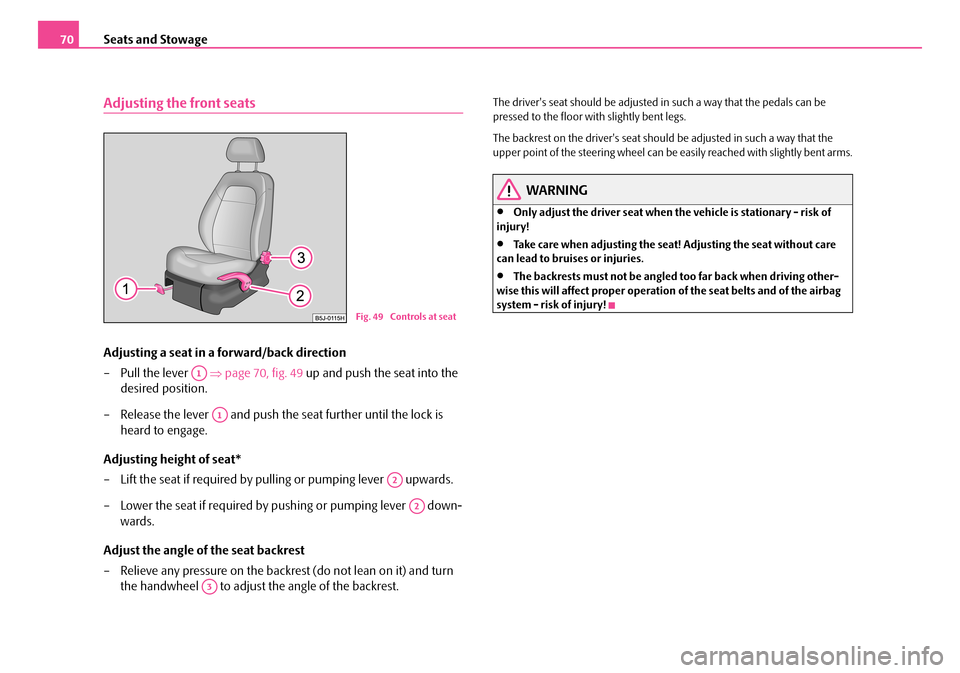
Seats and Stowage70
Adjusting the front seats
Adjusting a seat in a forward/back direction
– Pull the lever ⇒page 70, fig. 49 up and push the seat into the
desired position.
– Release the lever and push the seat further until the lock is
heard to engage.
Adjusting height of seat*
– Lift the seat if required by pulling or pumping lever upwards.
– Lower the seat if required by pushing or pumping lever down-
wards.
Adjust the angle of the seat backrest
– Relieve any pressure on the backrest (do not lean on it) and turn
the handwheel to adjust the angle of the backrest.
The driver's seat should be adjusted in such a way that the pedals can be pressed to the floor with slightly bent legs.
The backrest on the driver's seat should be adjusted in such a way that the upper point of the steering wheel can be easily reached with slightly bent arms.
WARNING
•Only adjust the driver seat when the vehicle is stationary - risk of injury!
•Take care when adjusting the seat ! Adjusting the seat without care can lead to bruises or injuries.
•The backrests must not be angled too far back when driving other- wise this will affect proper operation of the seat belts and of the airbag system - risk of injury!Fig. 49 Controls at seat
A1
A1
A2
A2
A3
NKO A05Fabia 20.book Page 70 Tuesday, September 26, 2006 8:38 AM
Page 72 of 258

Seats and Stowage71
Using the systemSafetyDriving TipsGeneral MaintenanceBreakdown assistanceTechnical Data
Head restraints
Best protection is achieved if the top edge of the head restraint is at
the same level as the u pper part of your head.
Adjusting the height of a head restraint
– Grasp the side of the head restraint with both hands and push the
head restraint in the direction of axle of the metal guide rods, in the
direction of arrow ⇒page 71, fig. 50 to the top or to the bottom.
– Move the head restraint downwards if required by pressing the
locking button ⇒page 71, fig. 51 and by pressing with the other
hand the head restraint downwards.
Removing and installing a head restraint
– Pull the head restraint out of the ba ckrest of the seat as far as the
stop.
– Press the locking button in the direction of arrow ⇒page 71,
fig. 51 and pull the head restraint out.
– To re-insert the head restraint, push it down into the backrest of the
seat far enough until you hear the locking button engage.
The position of the front, rear outer head restraints and the rear middle head restraint* is adjustable for height.
The head restraints must be adjusted to match the size of the seat occupant. Correctly adjusted head restraints togeth er with the seat belts offer effective protection for the occupants ⇒page 135.
WARNING
•The head restraints must be correctly adjusted in order to offer effec- tive protection for the occupants in the event of an accident.
•Do not drive under any circumstance with removed head restraints - risk of injury!
Fig. 50 Adjusting head restraint
Fig. 51 Removing a head restraint
NKO A05Fabia 20.book Page 71 Tuesday, September 26, 2006 8:38 AM
Page 75 of 258
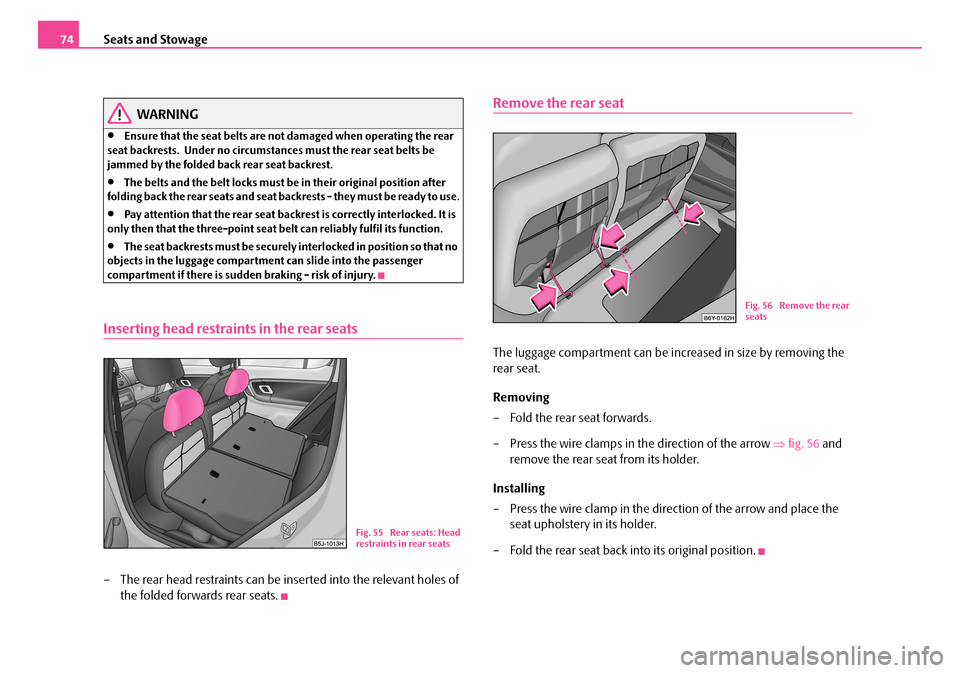
Seats and Stowage74
WARNING
•Ensure that the seat belts are not damaged when operating the rear seat backrests. Under no circumstances must the rear seat belts be jammed by the folded back rear seat backrest.
•The belts and the belt locks must be in their original position after folding back the rear seats and seat backrests - they must be ready to use.
•Pay attention that the rear seat backrest is correctly interlocked. It is only then that the three-point seat belt can reliably fulfil its function.
•The seat backrests must be securely interlocked in position so that no objects in the luggage compartmen t can slide into the passenger compartment if there is sudde n braking - risk of injury.
Inserting head restraints in the rear seats
– The rear head restraints can be inserted into the relevant holes of
the folded forwards rear seats.
Remove the rear seat
The luggage compartment can be increased in size by removing the
rear seat.
Removing
– Fold the rear seat forwards.
– Press the wire clamps in the direction of the arrow ⇒fig. 56 and
remove the rear seat from its holder.
Installing
– Press the wire clamp in the direction of the arrow and place the
seat upholstery in its holder.
– Fold the rear seat back into its original position.
Fig. 55 Rear seats: Head restraints in rear seats
Fig. 56 Remove the rear seats
NKO A05Fabia 20.book Page 74 Tuesday, September 26, 2006 8:38 AM
Page 76 of 258
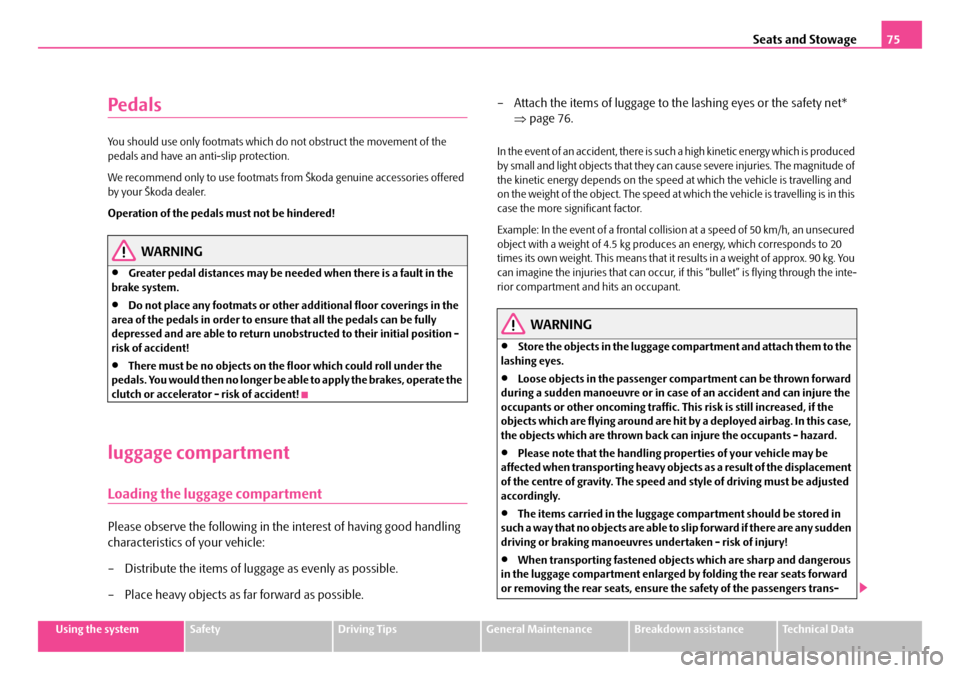
Seats and Stowage75
Using the systemSafetyDriving TipsGeneral MaintenanceBreakdown assistanceTechnical Data
Pedals
You should use only footmats which do not obstruct the movement of the pedals and have an anti-slip protection.
We recommend only to use footmats from Škoda genuine accessories offered by your Škoda dealer.
Operation of the pedals must not be hindered!
WARNING
•Greater pedal distances may be need ed when there is a fault in the brake system.
•Do not place any footmats or other additional floor coverings in the area of the pedals in order to ensure that all the pedals can be fully depressed and are able to return unobstructed to their initial position - risk of accident!
•There must be no objects on the floor which could roll under the pedals. You would then no longer be able to apply the brakes, operate the clutch or accelerator - risk of accident!
luggage compartment
Loading the luggage compartment
Please observe the following in the interest of having good handling
characteristics of your vehicle:
– Distribute the items of luggage as evenly as possible.
– Place heavy objects as far forward as possible.
– Attach the items of luggage to the lashing eyes or the safety net*
⇒ page 76.
In the event of an accident, there is such a high kinetic energy which is produced by small and light objects that they can cause severe injuries. The magnitude of the kinetic energy depends on the speed at which the vehicle is travelling and on the weight of the object. The speed at which the vehicle is travelling is in this case the more significant factor.
Example: In the event of a frontal collision at a speed of 50 km/h, an unsecured object with a weight of 4.5 kg produc es an energy, which corresponds to 20 times its own weight. This means that it results in a weight of approx. 90 kg. You can imagine the injuries that can occur, if this “bullet” is flying through the inte- rior compartment and hits an occupant.
WARNING
•Store the objects in the luggage comp artment and attach them to the lashing eyes.
•Loose objects in the passenger compartment can be thrown forward during a sudden manoeuvre or in case of an accident and can injure the occupants or other oncoming traffic. This risk is still increased, if the objects which are flying around are hit by a deployed airbag. In this case, the objects which are thrown back can injure the occupants - hazard.
•Please note that the handling properties of your vehicle may be affected when transporting heavy objects as a result of the displacement of the centre of gravity. The speed an d style of driving must be adjusted accordingly.
•The items carried in the luggage compartment should be stored in such a way that no objects are able to slip forward if there are any sudden driving or braking manoeuvres undertaken - risk of injury!
•When transporting fastened objects which are sharp and dangerous in the luggage compartment enlarged by folding the rear seats forward or removing the rear seats, ensure the safety of the passengers trans-
NKO A05Fabia 20.book Page 75 Tuesday, September 26, 2006 8:38 AM
Page 77 of 258
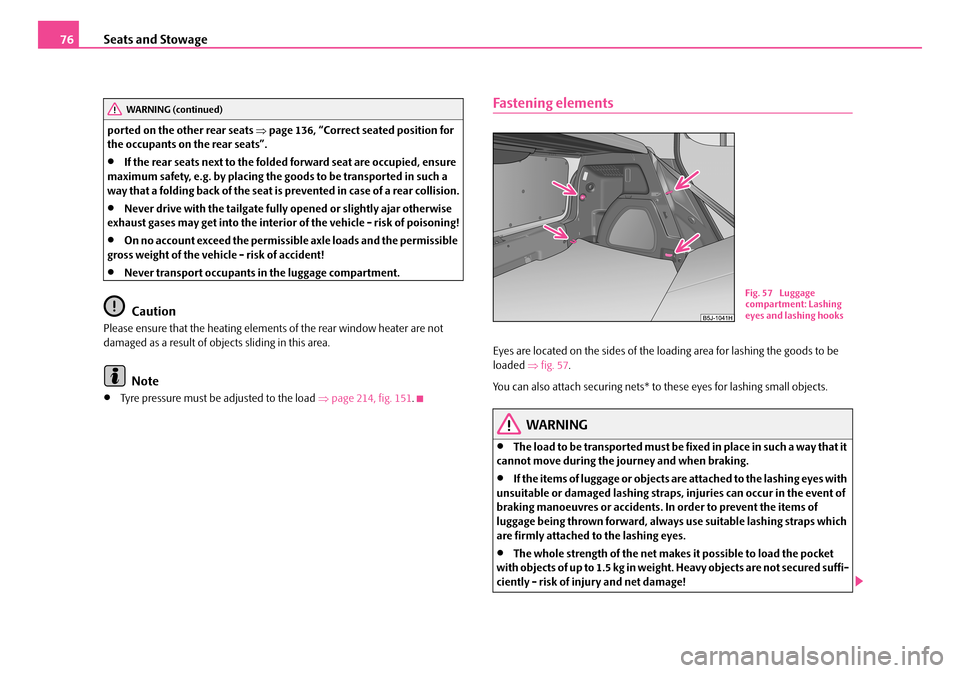
Seats and Stowage76
ported on the other rear seats ⇒page 136, “Correct seated position for the occupants on the rear seats”.
•If the rear seats next to the folded forward seat are occupied, ensure maximum safety, e.g. by placing the goods to be transported in such a way that a folding back of the seat is prevented in case of a rear collision.
•Never drive with the tailgate fully opened or slightly ajar otherwise exhaust gases may get into the interior of the vehicle - risk of poisoning!
•On no account exceed the permissible axle loads and the permissible gross weight of the vehicle - risk of accident!
•Never transport occupants in the luggage compartment.
Caution
Please ensure that the heating elements of the rear window heater are not damaged as a result of objects sliding in this area.
Note
•Tyre pressure must be adjusted to the load ⇒page 214, fig. 151.
Fastening elements
Eyes are located on the sides of the loading area for lashing the goods to be loaded ⇒fig. 57.
You can also attach securing nets* to these eyes for lashing small objects.
WARNING
•The load to be transported must be fixed in place in such a way that it cannot move during the journey and when braking.
•If the items of luggage or objects ar e attached to the lashing eyes with unsuitable or damaged lashing straps, injuries can occur in the event of braking manoeuvres or accidents. In order to prevent the items of luggage being thrown forward, always use suitable lashing straps which are firmly attached to the lashing eyes.
•The whole strength of the net makes it possible to load the pocket with objects of up to 1.5 kg in weight. Heavy objects are not secured suffi- ciently - risk of injury and net damage!
WARNING (continued)
Fig. 57 Luggage compartment: Lashing eyes and lashing hooks
NKO A05Fabia 20.book Page 76 Tuesday, September 26, 2006 8:38 AM
Page 78 of 258

Seats and Stowage77
Using the systemSafetyDriving TipsGeneral MaintenanceBreakdown assistanceTechnical Data
•The load to be transported must be fixed in place in such a way that it cannot move during the journey and when braking.
Folding hooks*
A folding hook* for attaching small items of luggage, such as bags etc., is provided on both sides of the luggage compartment ⇒fig. 58.
An item of luggage weighing up to 10 kg can be attached to the hook.
The luggage compartment cover
You can use the luggage compartment cover behind the head
restraints for storing light and soft items.
The luggage compartment cover can be removed as required if one
must transport bulky goods.
– Unhook the support straps on the tailgate ⇒fig. 59.
– Slightly raise the luggage compartment cover.
– Remove the luggage compartment cover from the holders by
pulling to the rear or with adequa te blows to the bottom side of the
luggage compartment cover in the area between the holders.
WARNING (continued)
Fig. 58 Luggage compartment: folding hooks
Fig. 59 Removing the luggage compartment cover
A1
A2
NKO A05Fabia 20.book Page 77 Tuesday, September 26, 2006 8:38 AM
Page 80 of 258
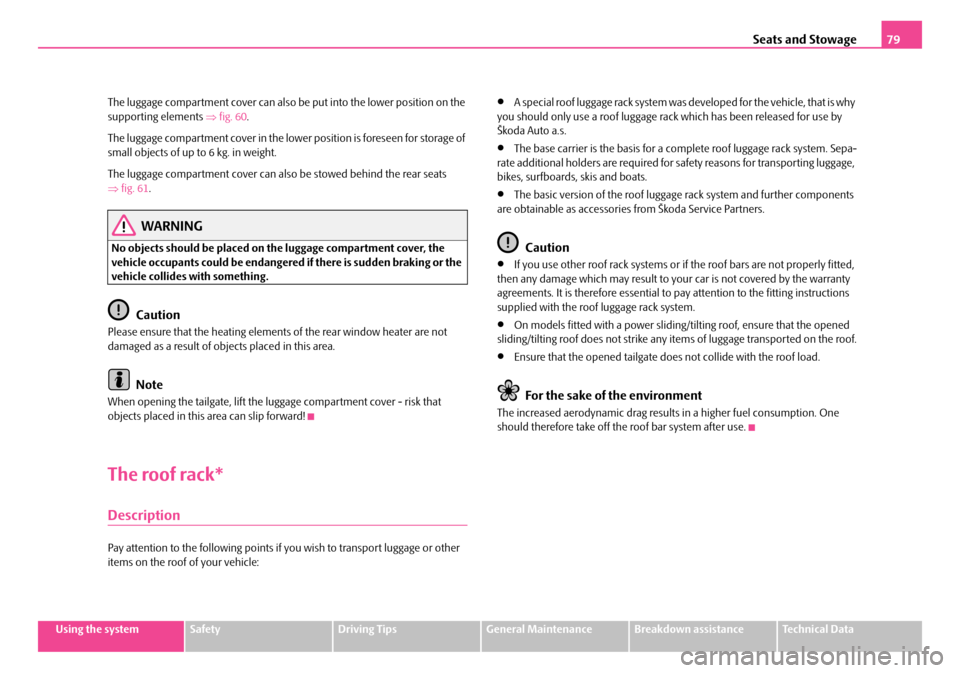
Seats and Stowage79
Using the systemSafetyDriving TipsGeneral MaintenanceBreakdown assistanceTechnical Data
The luggage compartment cover can also be put into the lower position on the supporting elements ⇒fig. 60.
The luggage compartment cover in the lower position is foreseen for storage of small objects of up to 6 kg. in weight.
The luggage compartment cover can also be stowed behind the rear seats ⇒ fig. 61.
WARNING
No objects should be placed on the luggage compartment cover, the vehicle occupants could be endangered if there is sudden braking or the vehicle collides with something.
Caution
Please ensure that the heating elements of the rear window heater are not damaged as a result of obje cts placed in this area.
Note
When opening the tailgate, lift the luggage compartment cover - risk that objects placed in this area can slip forward!
The roof rack*
Description
Pay attention to the following points if you wish to transport luggage or other items on the roof of your vehicle:
•A special roof luggage rack system was developed for the vehicle, that is why you should only use a roof luggage rack which has been released for use by Škoda Auto a.s.
•The base carrier is the basis for a comp lete roof luggage rack system. Sepa- rate additional holders are required for safety reasons for transporting luggage, bikes, surfboards, skis and boats.
•The basic version of the roof luggage rack system and further components are obtainable as accessories from Škoda Service Partners.
Caution
•If you use other roof rack systems or if the roof bars are not properly fitted, then any damage which may result to yo ur car is not covered by the warranty agreements. It is therefore essential to pay attention to the fitting instructions supplied with the roof luggage rack system.
•On models fitted with a power sliding/ tilting roof, ensure that the opened sliding/tilting roof does not strike any items of luggage transported on the roof.
•Ensure that the opened tailgate does not collide with the roof load.
For the sake of the environment
The increased aerodynamic drag results in a higher fuel consumption. One should therefore take off the roof bar system after use.
NKO A05Fabia 20.book Page 79 Tuesday, September 26, 2006 8:38 AM
Page 81 of 258
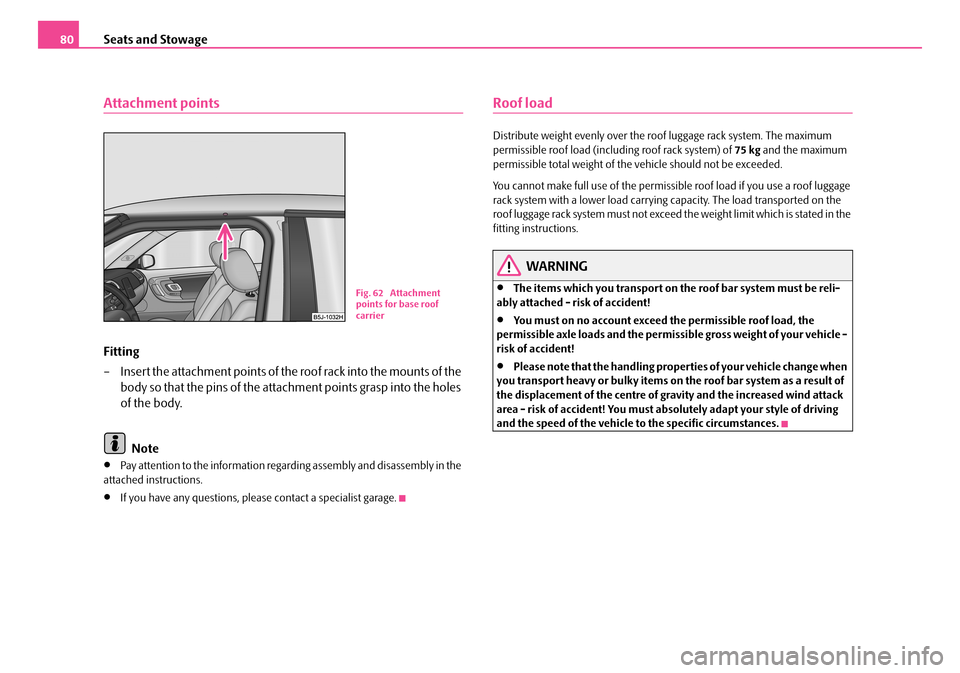
Seats and Stowage80
Attachment points
Fitting
– Insert the attachment points of th e roof rack into the mounts of the
body so that the pins of the attachment points grasp into the holes
of the body.
Note
•Pay attention to the information regarding assembly and disassembly in the attached instructions.
•If you have any questions, plea se contact a specialist garage.
Roof load
Distribute weight evenly over the roof luggage rack system. The maximum permissible roof load (inclu ding roof rack system) of 75 kg and the maximum permissible total weight of the vehicle should not be exceeded.
You cannot make full use of the permissibl e roof load if you use a roof luggage rack system with a lower load carrying capacity. The load transported on the roof luggage rack system must not exceed the weight limit which is stated in the fitting instructions.
WARNING
•The items which you transport on the roof bar system must be reli-ably attached - risk of accident!
•You must on no account exceed the permissible roof load, the permissible axle loads and the permissi ble gross weight of your vehicle - risk of accident!
•Please note that the handling prop erties of your vehicle change when you transport heavy or bulky items on the roof bar system as a result of the displacement of the centre of gravity and the increased wind attack area - risk of accident! You must absolutely adapt your style of driving and the speed of the vehicle to the specific circumstances.
Fig. 62 Attachment points for base roof carrier
NKO A05Fabia 20.book Page 80 Tuesday, September 26, 2006 8:38 AM
Page 82 of 258

Seats and Stowage81
Using the systemSafetyDriving TipsGeneral MaintenanceBreakdown assistanceTechnical Data
Front cup holder
You can place two cups or beverage cans into the recesses ⇒fig. 63.
WARNING
•Do not place any hot beverages into the cup holder. If the vehicle moves, the hot beverages may spill - risk of scalding!
•Do not use any cups or beakers which are made of brittle material (e.g. glass, porcelain). You might be injured by them in the event of an accident.
Caution
Do not open the beverages in the cup holder while driving. There is a risk of spilling e.g. when braking and therefore the electrical components or the seat upholstery can be damaged.
Rear cup holder*
You can place one cup or beverage can into the recess ⇒fig. 64.
WARNING
•Do not place any hot beverages into the cup holder. If the vehicle moves, the hot beverages may spill - risk of scalding!
•Do not use any cups or beakers wh ich are made of brittle material (e.g. glass, porcelain). You might be injured by them in the event of an accident.
Caution
Do not open the beverages in the cup hold er while driving. There is a risk of spilling e.g. when braking and therefore the electrical components or the seat upholstery can be damaged.
Fig. 63 Front centre console: Cup holderFig. 64 Centre console: Cup holder
NKO A05Fabia 20.book Page 81 Tuesday, September 26, 2006 8:38 AM
Page 84 of 258

Seats and Stowage83
Using the systemSafetyDriving TipsGeneral MaintenanceBreakdown assistanceTechnical Data
Removing ashtray
– Remove the ashtray ⇒fig. 66 upwards. When removing do not
hold the ashtray at the cover - risk of breakage.
Replacing ashtray
– Insert the ashtray vertically.
WARNING
Never lay flammable objects in the ashtray basin - risk of fire!
Cigarette lighter* and power sockets*
Cigarette lighter
You can also use the socket on the cigarette lighter for other
electrical appliances.
Using the cigarette lighter
– Press in the button of the cigarette lighter ⇒fig. 68.
– Wait until the button jumps forward.
– Remove the cigarette lighter immediately and use it.
– Insert the cigarette lighter again into the socket.
Using the power socket
– Take out the cigarette lighter.
Fig. 68 Centre console: Cigarette lighter
NKO A05Fabia 20.book Page 83 Tuesday, September 26, 2006 8:38 AM